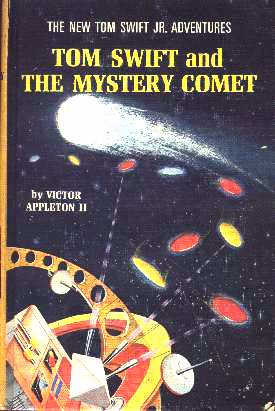
Tom Swift and the Mystery Comet
By Victor Appleton II
Summary:
Extracted from one of the title pages of the book:Tom Swift Jr. realizes one of his greatest ambitions when the U. S. space agency commissions him to do a comet probe. With his latest invention, the telesampler, Tom hopes to glean unknown scientific facts from the next comet to pass near earth-- and even, perhaps, make a manned landing. But his erstwhile enemies the Brungarians are a threat to the daring research project and U. S. scientific prestige.
Meanwhile, weird unidentified flying objects blazing across earth's skies are causing the U. S. Department of Defense great concern. When Professor Feng, of the University of Heildelberg, gives Tom a strange clue to the UFO's -- a clue that dates back to the Middle Ages -- the young space scientist is soon caught up in a web of danger and intrigue.
How Tom succeeds in solving the complex riddle of the UFO's -- just in time for a desperate race with a deadly comet as earth's fate hangs in the balance -- makes one of the most tension-packed, thrilling stories in the Tom Swift series.
![]()
Major Inventions
Unlike most of the other books in the series, there aren't any really big inventions in this book. There is one invention, however, and as it is pretty important (to the story, anyway), I'll discuss it here. That invention is the
Telesampler. (Do you see the diamond thing on the cover of the book? That is the Telesampler.) The Telesampler is actually a small one-way transporter, as it "beams" up small portions of material -- any material -- and ships them back to a container, where they materialize -- but don't reassemble to create the original object.
How does the Telesampler work?
In the words of Tom Swift:"Íthe device operates by an electromagnetic wave action. In principle at least, it can work at ranges of hundreds of thousands of miles."
"Hoppin' horned toads!" the cook blurted. "Then if I cooked up a mess o' frijole beans out in Texas, you could sample 'em right here in Shopton--is that what you're sayin'?"
"I could if I had a clear line of sight and my telesampler generator enough power. This experimental lab setup couldn't do it, of course. Anyhow," Tom added with a chuckle, "I'd rather have you dishing up chuck at Enterprises, pard."
As the boys tackled the appetizing lunch of steak and French fried potatoes, Chow continued to peer at the telesampler. "How does she work, boss?"
"Well, the antenna pulses out a concentrated beam that knocks particles loose from the surface of the target substance," Tom explained between mouthfuls, "the same way a beam of light makes a photoelectric cell give off electrons."
"How d'ye make them lil bitty party-cules o' the stuff come back to you?" Chow asked.
"They're in an ionized state, so the echo -- or reflected beam -- carries them back to the telesampler. And the tubing connected to the antenna dish is a wave guide that carries the particles to the tank--which is the box Bud was scooping the icing from."
How feasible is it to build a Telesampler?
The whole thing, I must admit, sounds just fine in theory. In fact, it is the most realistic description of a transporter that I have ever seen in science fiction. However, something about the carry-the-particles-back stage bothers me. Why would the particles be carried back to the telesampler by the reflected beam of light? Can light -- which is merely an electromagnetic wave -- carry objects? I don't think so, but I could be wrong. Are there any scientists out there that could solve this one for me?Even if it did work, though, I would suspect that it would use enormous quantities of electrical power -- effectively making it quite unfeasible.
How much impact would a Telesampler have on civilization?
The Telesampler would most likely have very, very few uses outside of geology. NASA, of course, would probably put it to use in the stead of a sample-return space probe. No longer is it necessary to send probes to planets to pick up specimens -- aim your trusty telesampler at the planet of your choice and beam up a few samples! Mining and oil companies might be able to use a modified telesampler to test for underground oil fields and mineral deposits -- no more costly, time-consuming drilling would be necessary. This would also be a great tool for aerial prospecting -- simply put the telesampler on automatic, hook it up to a computer, and let it rip. Then, a few hours later, come back and see what samples you have and where the deposits are.The use of the Telesampler would be greatly limited because of two important things: it cannot beam objects up from underneath things, and it cannot reassemble them to form the original object. This makes the Telesampler very realistic, but it hardly expands its potential usesÍ
If I have missed any inventions or if there is any information you would like to see on this page please let me know.
![]()
Tom Swift and his Subocean Geotron | Tom Swift and the Captive Planetoid | Index